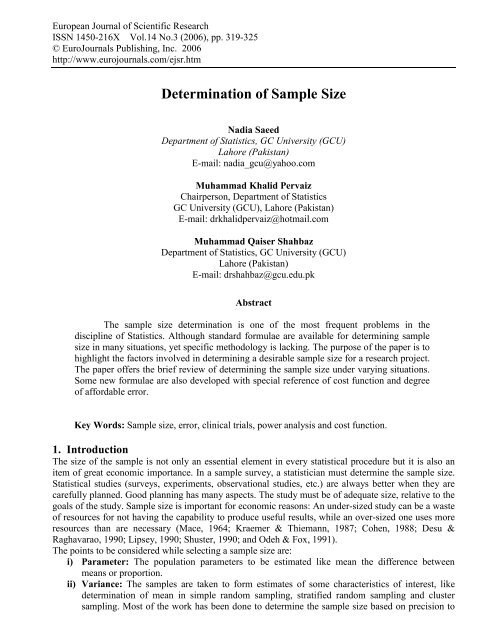European Journal of Scientific Research - EuroJournals
European Journal of Scientific Research - EuroJournals
European Journal of Scientific Research - EuroJournals
You also want an ePaper? Increase the reach of your titles
YUMPU automatically turns print PDFs into web optimized ePapers that Google loves.
<strong>European</strong> <strong>Journal</strong> <strong>of</strong> <strong>Scientific</strong> <strong>Research</strong><br />
ISSN 1450-216X Vol.14 No.3 (2006), pp. 319-325<br />
© Euro<strong>Journal</strong>s Publishing, Inc. 2006<br />
http://www.eurojournals.com/ejsr.htm<br />
Determination <strong>of</strong> Sample Size<br />
Nadia Saeed<br />
Department <strong>of</strong> Statistics, GC University (GCU)<br />
Lahore (Pakistan)<br />
E-mail: nadia_gcu@yahoo.com<br />
Muhammad Khalid Pervaiz<br />
Chairperson, Department <strong>of</strong> Statistics<br />
GC University (GCU), Lahore (Pakistan)<br />
E-mail: drkhalidpervaiz@hotmail.com<br />
Muhammad Qaiser Shahbaz<br />
Department <strong>of</strong> Statistics, GC University (GCU)<br />
Lahore (Pakistan)<br />
E-mail: drshahbaz@gcu.edu.pk<br />
Abstract<br />
The sample size determination is one <strong>of</strong> the most frequent problems in the<br />
discipline <strong>of</strong> Statistics. Although standard formulae are available for determining sample<br />
size in many situations, yet specific methodology is lacking. The purpose <strong>of</strong> the paper is to<br />
highlight the factors involved in determining a desirable sample size for a research project.<br />
The paper <strong>of</strong>fers the brief review <strong>of</strong> determining the sample size under varying situations.<br />
Some new formulae are also developed with special reference <strong>of</strong> cost function and degree<br />
<strong>of</strong> affordable error.<br />
Key Words: Sample size, error, clinical trials, power analysis and cost function.<br />
1. Introduction<br />
The size <strong>of</strong> the sample is not only an essential element in every statistical procedure but it is also an<br />
item <strong>of</strong> great economic importance. In a sample survey, a statistician must determine the sample size.<br />
Statistical studies (surveys, experiments, observational studies, etc.) are always better when they are<br />
carefully planned. Good planning has many aspects. The study must be <strong>of</strong> adequate size, relative to the<br />
goals <strong>of</strong> the study. Sample size is important for economic reasons: An under-sized study can be a waste<br />
<strong>of</strong> resources for not having the capability to produce useful results, while an over-sized one uses more<br />
resources than are necessary (Mace, 1964; Kraemer & Thiemann, 1987; Cohen, 1988; Desu &<br />
Raghavarao, 1990; Lipsey, 1990; Shuster, 1990; and Odeh & Fox, 1991).<br />
The points to be considered while selecting a sample size are:<br />
i) Parameter: The population parameters to be estimated like mean the difference between<br />
means or proportion.<br />
ii) Variance: The samples are taken to form estimates <strong>of</strong> some characteristics <strong>of</strong> interest, like<br />
determination <strong>of</strong> mean in simple random sampling, stratified random sampling and cluster<br />
sampling. Most <strong>of</strong> the work has been done to determine the sample size based on precision to

















